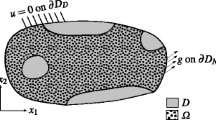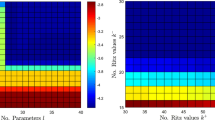Abstract
The Fritz John conditions for Pareto-optimality have been set in matrix form and used for introducing a procedure for the analytical derivation of the Pareto-optimal set in the design variables domain. Subsequently, the derivation of the Pareto-optimal set in the objective functions domain can be obtained, if possible, by a proper analytical derivation. Both the objective and constraint functions are assumed to be available in analytical form and twice differentiable and convex (or pseudo-convex). The proposed procedure to find the Pareto-optimal set is relatively simple. The computation of the determinant of a matrix is required. A symbolic manipulator can be exploited. If there are two design variables and two objective functions, the Pareto-optimal set can be easily computed by applying a simple formula derived in the paper. If the number of design variables equals the number of objective functions, the Pareto-optimal set in the design variables domain can be found by computing the product of the constraint functions times the determinant of the Jacobian of the objective functions. A number of case studies have been proposed to test the effectiveness of the proposed procedure. The optimal structural design of, respectively, a pair of compressed spheres, a cantilever with rectangular cross section have been faced and solved. Additionally the test problem proposed by Fonseca and Fleming has been addressed and solved analytically. Optimization problems with low dimensionality (2 or 3 design variables and 2 objective functions, 2 or more constraints) have been easily solved. The proposed procedure can be useful in the actual engineering practice at the earliest design stage. In this case the designer can be made aware on the proper design variables setting to obtain the desired tradeoff among conflicting objective functions.











Similar content being viewed by others
Notes
b and h may vary, respectively, within two well defined ranges
References
Aghezzaf B, Hachimi M (1999) Second-order optimality conditions in multi-objective optimization problems. J Optim Theory Appl 102(1):37–50
Anton H, Rorres C (2005) Elementary linear algebra, 9th edn. Wiley. (ISBN 978-0-471-66959-3)
Arora JS (2004) Introduction to optimal design. Elsevier Academic Press, UK
Askar SS, Tiwari A (2009) Finding exact solutions for multi-objective optimization problems using a symbolic algorithm. In: Proc IEEE Congress Evol Comput, pp 24–30
Benoist J (1998) Connectedness of the efficient solutions for vector maximization problems. J Optim Theor Appl 96(3)
Bendsoe MP, Sigmund O (2003) Topology optimization: theory, methods and applications. Springer Verlag, Berlin
Bjorck A (1996) Numerical methods for least squares problems. Society for industrial and applied mathematics. Philadelphia
Chawla N, Deng X (2005) Microstructure and mechanical behavior of porous sintered steels. Mater Sci Eng A 390:98–112
Ehrgott M, Klamroth K (1997) Connectedness of the efficient solutions in multiple criteria combinatorial optimization. Eur J Oper Res 97(1)
Erfani T, Utyuzhnikov SV, Kolo B (2013) A modified directed search domain algorithm for multi-objective engineering and design optimization. Struct Multidiscip Optim:1–13
Fonseca CM, Fleming PJ (1998) Multi-objective optimization and multiple constraint handling with evolutionary algorithms Part II: application example. IEEE Trans Syst Man Cybern
Gobbi M, Levi F, Mastinu G (2006) Multi-objective stochastic optimisation of the suspension system of road vehicles. J Sound Vib 298(4–5):1005–1072
Gobbi M, Levi F, Mastinu G (2005) An application of multi-objective stochastic optimisation to structural design. Struct Multidiscip Optim 29(4):272–284
Gobbi M, Mastinu G (2001) On the optimal design of composite material tubular helical springs. Meccanica 36(5):525–553
Gobbi M (2012) A k, k- 𝜖 optimality selection based multi-objective genetic algorithm with applications to vehicle engineering. Optim Eng. doi:10.1007/s11081-011-9185-8
Haimes Y, Lasdon LS, Wismer DA (1971) On a Bicriterion formulation of the problems of integrated system identification and system optimization. IEEE Trans Syst Man Cybern 1(3):296–297
Kim DS, et al. (2001) Counterexample and optimality conditions in differentiable multi-objective programming. J Optim Theory Appl 109(1):187–192
Levi F, Gobbi M (2006) An application of analytical multi-objective optimization to truss structures., (AIAA 2006-6975). In: 11th AIAA/ISSMO multidisciplinary analysis and optimization conference. Portsmouth
Marler R, Arora J (2004) Survey of multi-objective optimization methods for engineering. Struct Multidiscip Optim 26:369–395
Marusciac I (1982) On the Fritz John type optimality criterion in multi-objective goal programming. Revue d’Analyse Numerique et de Theorie de l’Approximation 11 No. 1–2
Mastinu G, Gobbi M, Miano C (2006) Optimal design of complex mechanical systems: with applications to vehicle engineering. Springer-Verlag. (ISBN-13:978-3540343547)
Meyer CD (2001) Matrix analysis and applied linear algebra. Society for industrial and applied mathematics (SIAM). Aurora
Miettinen K (1999) Nonlinear multi-objective optimization. Kluwer Academic Publishers, Boston
Papalambros PY, Wilde DJ (2000) Principles of optimal design. Modeling and computation. Cambridge University Press, Cambridge
Pedersen P, Pedersen NL (2009) Analytical optimal designs for long and short statically determinate beam structures. Struct Multidiscip Optim 39(4):343–357
Rozvany GNI (1989) Structural design via optimality criteria. Kluwer, Dordrecht
Siddiqui S, Azarm S, Gabriel SA (2012) On improving normal boundary intersection method for generation of Pareto frontier. Struct Multidiscip Optim 46(6):839–852
Simon CP, Blume LE (1994) Mathematics for economists. W. W. Norton and Company
Takayama A (1993) Analytical methods in economics. University of Michigan Press
Yang XQ, Jeyakumar V (1997) First and second-order optimality conditions for convex composite multi-objective optimization. J Optim Theory Appl 95(1):209–224
Young WC, Budynas RG (2002) Roark’s formulas for stress and strain. Mc Graw Hill, New York
Zhang WH, Yang HC (2002) Efficient gradient calculation of the Pareto optimal curve in multicriteria optimisation. Struct Multidiscip Optim 23:311–319
Author information
Authors and Affiliations
Corresponding author
Rights and permissions
About this article
Cite this article
Gobbi, M., Levi, F., Mastinu, G. et al. On the analytical derivation of the Pareto-optimal set with applications to structural design. Struct Multidisc Optim 51, 645–657 (2015). https://doi.org/10.1007/s00158-014-1152-5
Received:
Revised:
Accepted:
Published:
Issue Date:
DOI: https://doi.org/10.1007/s00158-014-1152-5




